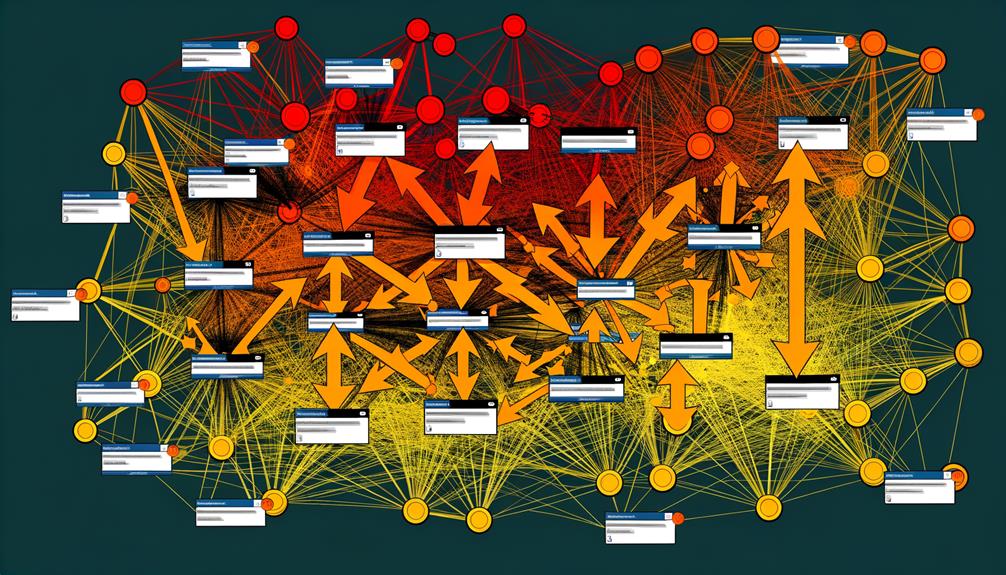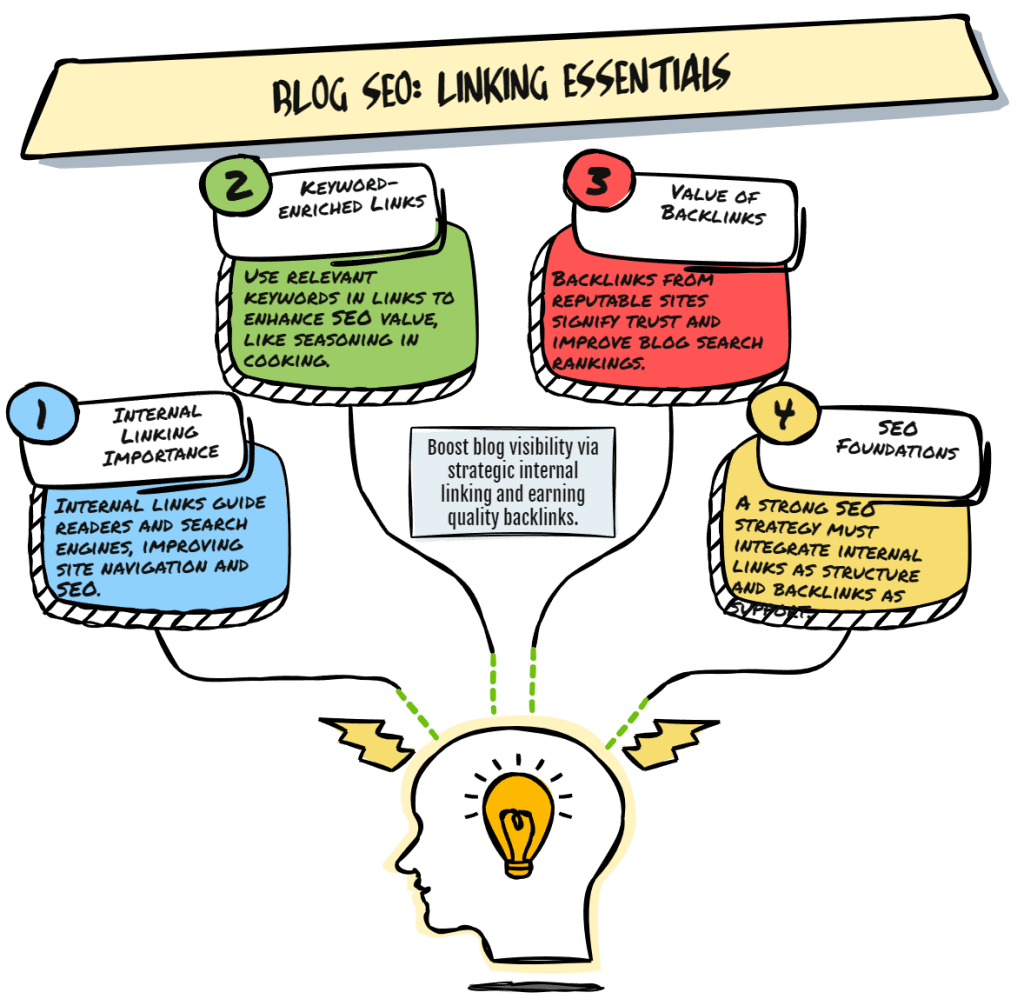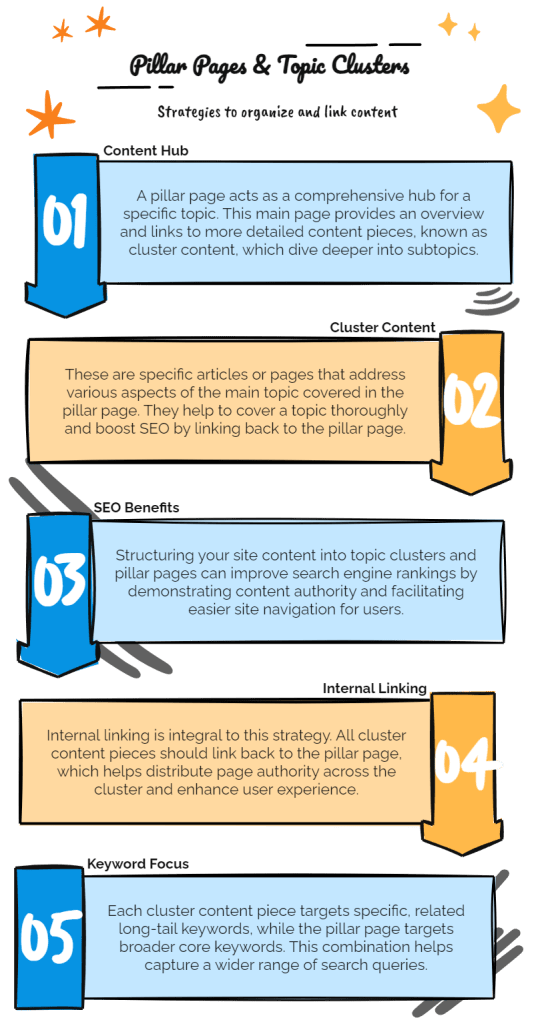

Internal linking and backlinking are two important tools for making your blog[1] more noticeable. Internal links tie your website’s pages together, making it easier to get around and telling search engines what your site is all about. This helps your pages get found quicker and rank higher.
Backlinks, on the other hand, are links from other websites that act like a thumbs up for your content. Good backlinks make your site matter more, so it shows up more in search results. The words you choose for your links and how relevant they are also matter a lot.
Want to know more? Stay tuned to learn more about these techniques and how to use them effectively.
To get the most out of your blog’s SEO, you need to understand something called internal linking. This is just a fancy way of saying that you link different pages on your website to each other. It helps organize your site, makes it easier for people to find what they’re looking for, and boosts your SEO.
These links are usually hidden in words or phrases, guiding your visitors to more relevant info. This makes your site more user-friendly. Plus, it helps search engines understand how your site is put together. This makes their job easier when they’re indexing your site.
If you use internal links smartly, you can improve your blog’s SEO and make it more enjoyable for your visitors. And guess what? There’s even more to learn about this simple yet powerful tool. Stay tuned…
Grasping the perks of internal links is key. They pack a punch with a host of benefits. Think faster indexing by search engines, better page rankings, lower bounce rates, and a superior user experience. They’re like a secret weapon for SEO, helping to shape your site’s structure and guiding search engines to your key pages. This boosts rankings.
Crafting internal links with care can do wonders. The right anchor text can lead users to the content they’re after, reducing bounce rates. Plus, it amps up the user experience. What’s more, internal links give your older pages a visibility boost, preventing them from being buried in the depths of your website. It’s clear – internal linking is an ace in the hole for SEO strategy. It’s a powerful tool to revamp your site, heighten its visibility, and propel its search engine rankings.

Let’s talk about a simple yet powerful tool for boosting your blog’s performance: internal linking. It’s like creating a roadmap within your site, guiding both users and search engines.
The secret lies in using the right keywords in your internal links, it not only makes them relevant but also increases their SEO value. Plus, it helps search engines understand and index your site better.
Think of your site as a spider web, using topic clusters and pillar pages, connected by internal links. This strengthens your site’s structure, making it strong and efficient.

Just like the way you link posts within your blog makes a difference, being a pro at backlinking is key to getting your blog noticed.
Backlinking is all about choosing the right words and phrases, and using them to link to your blog from high-quality, respected sites. By doing this, you’re telling search engines that your blog is relevant and high-quality. This can help your blog appear higher in search results.
But remember, all backlinks aren’t the same. Focus on quality, not quantity. Get backlinks from trustworthy sites that are related to your blog. This way, your blog has the best chance at getting the most out of SEO.
What’s next in mastering the art of backlinking? Stay tuned to find out.
Quality backlinks can make your blog shine in the eyes of search engines. Think of them as thumbs-up from trusted sources, signaling your content’s worth. These digital nods boost your blog’s SEO, helping it climb the search engine ranks. And guess what? Higher ranks mean more organic visits to your blog. It’s like a snowball effect.
The trick is to choose quality over quantity. A few backlinks from respected sources can do more good than a truckload from suspicious corners of the web. So, how do you do it? Build a smart backlink[2] profile with a focus on quality.
| Quality Backlinks | What they do | How to get them |
|---|---|---|
| Thumbs-up from trusted sources | Make your blog an SEO superstar | Be smart, choose quality |
| Elevate search engine ranks | Attract more organic visits | Build a strong backlink profile |
| Show your blog’s worth | Signal trust and authority | Improve your blog’s internal linking |
To boost your blog’s visibility on search engines, you must craft a strong plan for backlinking. This means getting links from reputable websites, naturally gaining backlinks, and keeping a close eye on the quality of these backlinks. You need to build a variety of backlinks that are all related to your topic. Concentrate on earning natural backlinks by providing top-notch content and reaching out strategically.
There are tools like Ahrefs or Moz that can help you analyze your backlinks, discover opportunities and track your progress. Be aware of harmful backlinks that could affect your blog’s search engine ranking negatively – it’s smart to disavow them. To get successful backlinks, you need to be proactive. This involves establishing a good relationship with influencers and website owners. But remember, tracking backlinks isn’t a one-time job, it’s an ongoing task that’s key to improving your blog’s visibility.
After carefully shaping a backlinking plan, the next step is to grasp how internal links and backlinks can power up your blog’s SEO.
Internal links are like signposts in a city, guiding visitors through your site by pointing them towards related content. This makes the journey through your website smoother and more enjoyable. They also help set up a clear information structure and distribute power among different pages, optimizing your site.
Backlinks, on the other hand, work like a popularity contest. The more you have, the more visible and authoritative your site becomes off-site. They tell search engines that your site is trustworthy, enhancing your SEO game.
| SEO Element | Impact on Your Site | Impact Outside Your Site |
|---|---|---|
| Internal Links | Makes Site Navigation Easier | – |
| Backlinks | – | Boosts Site Visibility & Authority |
In short, internal linking and backlinks are key players in a successful SEO game plan.
Navigating the world of internal links and backlinks can be tricky. You’ll need to tackle problems like ‘orphaned’ webpages, controlling how deeply a search engine crawls your site, and fixing chains of redirects. These tasks are key to boosting how well your blog ranks in search engine results. A review of your internal links will highlight any issues.
By understanding how deep a search engine crawls and how many links you should have on each page, you can tailor your site to be more search engine-friendly. The right anchor text can tell Google[3] not to follow certain links, helping balance link equity. Our handy guide highlights why links matter and how they help search engines discover your internal pages.
With the right skills, you can link to other pages effectively, conquering many challenges and improving your blog’s SEO.
Don’t let SEO challenges hold back your business. Partner with us for cutting-edge SEO solutions that drive traffic and enhance visibility. Visit our contact page to learn more, or connect with us on WhatsApp for immediate support and start seeing results!
Digging deeper into the world of SEO, it’s key to understand and use advanced linking methods in your blog. This will make your blog more noticeable and rank higher. A well thought out strategy for linking within your blog is crucial.
Use words that people search for in your links to improve SEO for your blog posts. This makes your content easier to find and rank. It’s a good idea to link key blog posts together, forming a clear web of useful information. But, be careful not to link too much as it can annoy your readers.
Regularly check your links to make sure they’re helping your SEO. By using these methods, your blog will become more noticeable, rank higher, and perform better in terms of SEO.
No, they’re not identical. Backlinking is all about getting links from other websites out there. It helps make your site seem more trustworthy and can boost your SEO rank. On the other hand, internal linking simply means linking pages on your own site. It makes getting around easier and spreads the ‘authority’ evenly across your site.
When it comes to adding internal links to your blog, think about choosing your anchor text carefully. It’s important to place links strategically throughout your post. Don’t forget to analyze the overall structure of your site. Always link to content that relates closely to the subject of your post. This makes it easier for your readers to navigate your site. It’s also a great way to evenly spread the value of your links across your blog. Make sure to repair any broken links and use tools that can help improve your blog’s SEO.
It’s suggested to include around 3 to 5 links within your blog post that lead to other relevant parts of your own website. But remember, don’t overdo it! Too many links can confuse your readers. It’s all about finding that sweet spot. Make sure your links are up-to-date and truly beneficial to your readers.
Absolutely, using internal links is a key move in SEO. It makes your website easier to explore, keeps visitors around longer, lowers people leaving quickly, and makes your site look better to Google. Think of anchor texts like breadcrumbs leading readers through your content, sharing value all around your site’s structure.
